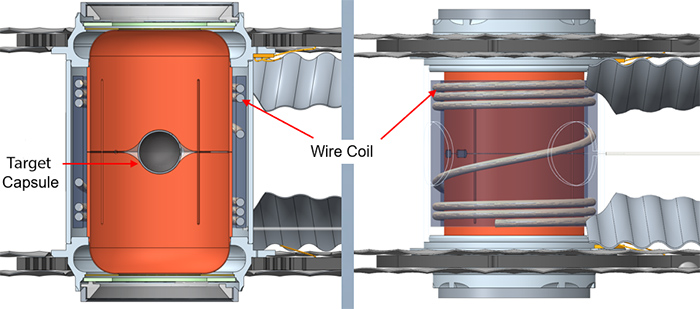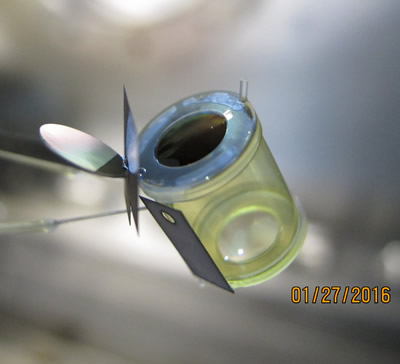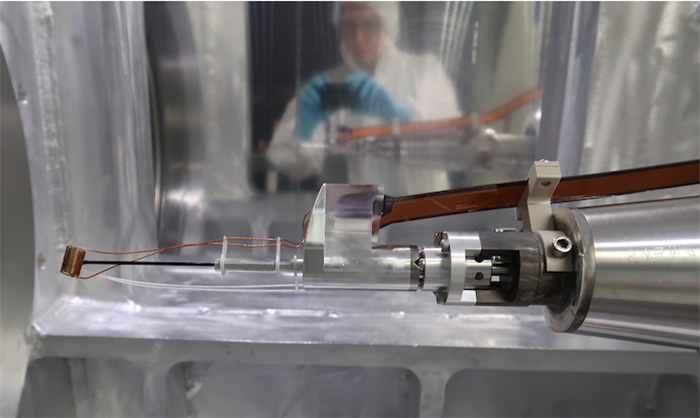Could Magnetized Targets Improve NIF’s Ignition Chances?
For the better part of a decade, inertial confinement fusion (ICF) researchers have been intrigued with the possibility that surrounding an ICF target with a powerful magnetic field could improve NIF’s implosion performance.
The idea has been tested, with promising results, in simulations and experiments at NIF and other facilities. Now LLNL researchers and their colleagues have been awarded a strategic initiative (SI) project to demonstrate the key elements of magnetically assisted ignition at NIF. The project is funded by the Laboratory Directed Research & Development (LDRD) program.
 Conceptual diagram of a NIF hohlraum fitted with a B-field (magnetic-field) coil.
Conceptual diagram of a NIF hohlraum fitted with a B-field (magnetic-field) coil. An international research team led by physicist John Moody is preparing to conduct an experimental campaign that will begin with an implosion experiment that uses a target capsule filled with cryogenic deuterium-tritium (DT) fuel.
“This experiment looks similar to an implosion we did previously on NIF that performed well,” Moody said. In the next step, “we add a coil of copper wire, known as the B-field (magnetic-field) coil, wrapped around the exterior of the hohlraum,” he said. “When the wire is energized by the NIF B-field pulser system it magnetizes the hohlraum and capsule.”
Moody describes the function of the coil around the hohlraum as helping to create a more effective implosion platform on NIF. “As soon as it is energized, current starts to flow in the coil,” he said. “This generates eddy currents in the hohlraum which slow the speed at which the field passes through the hohlraum wall. Eventually, the field fills the hohlraum and capsule.
“The starting B-field is called the seed field,” Moody added. “The implosion dramatically amplifies this seed field to the point where it can confine electrons and alpha particles generated in DT reactions. These two effects push the system closer to the self-heating regime.”
In an ICF experiment, the energy of NIF’s 192 lasers is focused on the interior walls of the hohlraum, generating x rays that drive the implosion of the target capsule filled with cryogenic DT fuel. When the implosion reaches its smallest size, the deuterium and tritium atoms in the hot-spot fuse and release alpha particles (helium nuclei) which deposit some of their energy in the surrounding cold fuel, stimulating additional fusion reactions through a process called alpha heating.
Improving Heat and Energy Containment
“But the hot-spot also loses energy through electron conduction and radiation,” Moody noted. “If we could better contain the electron heat and alpha-particle energy, this could lead to a self-sustaining ‘burning plasma’ and eventually, as other issues are resolved, to fusion ignition”—when a self-sustaining thermonuclear reaction releases more energy than the amount of energy absorbed by the target.
“When you apply the magnetic field,” Moody said, “the alpha particles remain longer in the hot-spot and the electron cooling decreases, making the hot-spot hotter, pushing the system closer to the self-heating regime, and bringing current ICF experiments closer to ignition. This is the advantage of using a B-field.”
Moody also expects that magnetically assisted ignition will significantly improve a target capsule’s performance with little or no change in the hohlraum’s behavior.
Beginning next summer, Moody’s SI team will begin a series of three laser shots on a room temperature hohlraum with a gas-filled capsule in a process to study the key elements for magnetized ignition.
 LLNL researchers, in collaboration with Sandia National Laboratories, have conducted a series of experiments designed to lay the groundwork for a magnetized ignition campaign on NIF over the last four years. The room-temperature “gas-pipe” target in the photo studied the propagation of a NIF quad (four beams) in a 10-millimeter-long epoxy pipe filled with one atmosphere of neo-pentane gas.
LLNL researchers, in collaboration with Sandia National Laboratories, have conducted a series of experiments designed to lay the groundwork for a magnetized ignition campaign on NIF over the last four years. The room-temperature “gas-pipe” target in the photo studied the propagation of a NIF quad (four beams) in a 10-millimeter-long epoxy pipe filled with one atmosphere of neo-pentane gas. The project’s goals are to demonstrate:
- A hot-spot temperature and neutron yield increase with an embedded B-field in a capsule;
- The system description and requirements for getting the B-field into a hohlraum consistent with NIF constraints, such as allowing full diagnostic access to the target and preventing optics damage;
- A viable DT ice-layering method that works with the B-field hardware; and
- The experimental platform for magnetized high energy density (HED)/high-field science.
After inducing a 30-Tesla seed field in the target capsule, Moody said, “we then will turn on the laser, and the resulting implosion traps the field in the capsule and amplifies it more than 200 times. This traps a lot of the heat from the electrons—which are usually very thermally conductive—in the hot-spot.
“Normally, without a magnetic field, the electrons are very effective at conducting generated heat out of the hot-spot,” he said. “But if you add a magnetic field the electrons have trouble carrying heat across the field. Electron heat stays confined in the hot-spot, so it takes longer to dissipate the heat out of the hot-spot, making the hot-spot even hotter, increasing chances of ignition.”
Along with the promise of improving NIF ICF implosions, magnetized targets also are generating interest for HED and astrophysics experiments. Several current NIF Discovery Science campaigns are studying astrophysical magnetic fields to determine their origins, how they evolve, and their role in other cosmic phenomena (see “Probing the Mysteries of Cosmic Magnetic Fields”).
To support the SI campaign, members of the NIF Target Fabrication Team and their partners at General Atomics have developed a number of specialized targets and target materials, ranging from solenoid-wrapped gas-filled pipes designed to measure debris and shrapnel to alloys for possible use in hohlraums with low electrical conductivity.
“While low conductivity is essential,” said Target Fabrication Chief Scientist Sergei Kucheyev, “these materials also need to be highly efficient for converting laser energy into x rays, machinable, and sufficiently thermally conductive, with mechanical properties and chemical stability required for reliable target assembly and delivery to the NIF.
“Our current gold hohlraums have very low electrical resistivity,” Kucheyev said, “but sputter-deposited gold-tantalum alloys with high tantalum content exhibit resistivity well above our current goal. While work to understand these alloys continues, we are also exploring vapor-deposited tantalum oxide or sub-oxide as another candidate hohlraum material.”
 A coil-wrapped gas-pipe target installed at the end of a NIF diagnostic instrument manipulator. Wrapping the coil around the gas-pipe presented a number of assembly challenges.
A coil-wrapped gas-pipe target installed at the end of a NIF diagnostic instrument manipulator. Wrapping the coil around the gas-pipe presented a number of assembly challenges. Moody expressed cautious optimism about the outcome of the team’s SI experimental campaign, based in part on previous magnetized liner inertial fusion (MagLIF) studies at the Z Machine at Sandia National Laboratories and the Omega Laser Facility at the University of Rochester, as well as hydrodynamic simulations of NIF target capsules with initial imposed magnetic fields of up to 70 Tesla.
The simulations, conducted by a team led by LLNL physicist John Perkins, show that the magnetic field enhances ICF implosion performance through range reduction (better confinement) of fusion alpha particles, suppression of electron heat conduction, and potential stabilization of higher-mode (shorter wavelength) hydrodynamic instabilities.
However, Moody said, the new campaign “isn’t the silver bullet to achieving self-heating. We could be surprised by an alternative set of physics resulting during this process. Plasmas are very good at avoiding being confined and dissipating their heat.
“As soon as you start bottling up the high-density and high temperature chunk of stuff, everything in physics tells you conditions will not continue to remain stable,” he said. “It’s like trying to contain and prolong an explosion—it’s unstable by definition. When we apply the B-field to our hohlraums, I’m sure we’ll encounter something other than what we expect; that’s an element of this work that makes it so interesting and challenging.”
Other Approaches to Self-Heating
Moody’s team also intends to explore other approaches to achieving self-heating. “We may find that a magnetic field used in combination with another hohlraum configuration will be more successful,” he said. “Or, we might find that a much higher seed field is needed.” For example, an approach being pursued by LLNL physicist Brad Pollock and his team uses lasers to generate high magnetic fields (see “Laser-Driven Magnetic Fields Could Boost NIF Implosions”).
Developing a magnetized implosion platform on NIF makes it possible to explore high-field science more thoroughly in the near future. “The project plan includes possible early offramps to the program, depending on our progress,” Moody said.
Along with Kucheyev, Target Fabrication Team members working on the magnetized hohlraums are Target Fabrication Chief Engineer Jeremy Kroll, Target Fabrication Engineer Trevor Plaine, and target assemblers Jean Jensen, Randy Strauser, Soojin Stadermann, and Nick Farmer.
Other members of Moody’s SI team are LLNL colleagues Bradley Pollock, Hong Sio, Grant Logan, David Strozzi, Darwin Ho, Jeff Bude, Warren Hsing, Mark Herrmann, Suhas Bhandarkar, Jonathan Fry, Evan Carroll, Scott Winters, Vincent Tang, Michael McDonald, Bernie Kozioziemski, Alison Engwall, Swanee Shin, Leonardas Bayu-Aji, Scott McCall, Alexander Baker, Jim Sater, Andrew Wray, John Bae, Xavier Lepro-Chavez, J. Beckham, Dennis Cocherell, Jesse Hamblen, Jon Gulko, Phil Arnold, Guadalupe Bracamontes, Elijah Kemp, Anthony Johnson, Jay Javedani, and Lisle Hagler, along with collaborators from the Laboratory for Laser Energetics at the University of Rochester, Sandia National Laboratories, Imperial College London, the Massachusetts Institute of Technology, the Soreq Nuclear Research Center and the Weizmann Institute of Science in Israel, Osaka University in Japan, and the University of Pittsburgh.
—Michael Garrison/Charlie Osolin
Follow us on Twitter: @lasers_llnl



